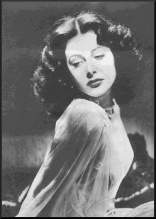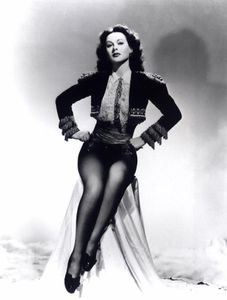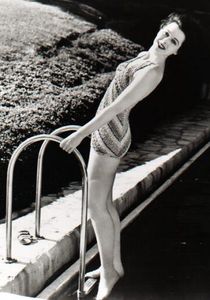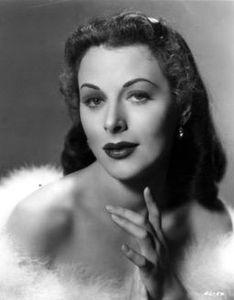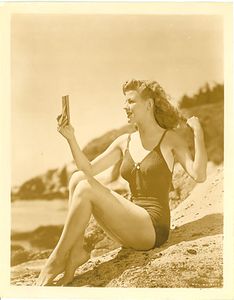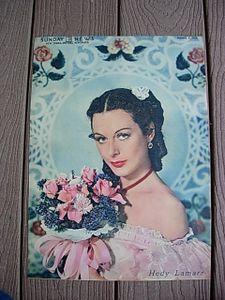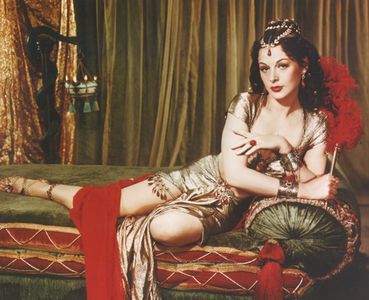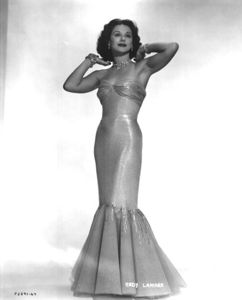Hedy Lamarr
Click here for Pin-up girl page |
Click here for Movie Star category page |
Click here for Category:YANK magazine pinups |
Hedy Lamarr (November 9, 1913 - January 19, 2000) was an Austrian-born American actress and communications technology innovator. Though known primarily for her great beauty and her successful film career, she also co-invented an early form of spread spectrum, a key to modern wireless communication.
Early career in Europe
She was born as Hedwig Eva Maria Kiesler in Vienna, Austrian Empire, to Emil Kiesler, a bank director, and Gertrud née Lichtwitz, pianist. She was raised as Catholic, and studied ballet and piano. When working with Max Reinhardt in Berlin, he called her the "most beautiful woman in Europe". Soon, the teenage girl played major roles in German movies, alongside stars like Heinz Rühmann and Hans Moser.
In early 1933, she starred in Symphonie der Liebe or Ecstasy, a Czechoslovak film made in Prague, in which she played a love-hungry young wife of an indifferent old husband. Closeups of her face in orgasm, and long shots of her running nude through the woods, gave the film notoriety.
On 10 August 1933 she married Friedrich Mandl, a Vienna-based arms manufacturer, 13 years older than herself. The Austrofascist bought up as many copies of the film as he could possibly find, as he objected to her nudity, as well as "the expression on her face" (the looks of passion were looks of pain, as the director poked her with a pin to get the desired effect). He prevented her from pursuing her acting career, and instead took her to meetings with technicians and business partners. In these meetings, the mathematically talented Hedy learned about military technology. Otherwise, she had to stay at Castle Schwarzenau, from which she ran away in 1937.
Frequency-hopped spread spectrum invention
Avant garde composer George Antheil, a son of German immigrants and neighbor of Lamarr, had experimented with automated control of instruments. Together, they submitted the idea of a Secret Communication System in June 1941. On 11 August 1942, U.S. Patent 2,292,387 was granted to Antheil and Hedy Kiesler Markey. This early version of frequency hopping used a piano roll to change between 88 frequencies and was intended to make radio-guided torpedoes harder for enemies to detect or jam.
The idea was impractical, ahead of its time, and infeasible due to the state of mechanical technology in 1942. It was not implemented in the USA until 1962, when it was used by U.S. military ships during a blockade of Cuba, after the patent had expired. Neither Lamarr nor Antheil (who died in 1959) made any money from the patent. Perhaps due to this lag in development, the patent was little-known until 1997, when the Electronic Frontier Foundation gave Lamarr an award for this contribution.
Lamarr's and Antheil's frequency-hopping idea serves as a basis for modern spread-spectrum communication technology used in devices ranging from cordless telephones to WiFi Internet connections, namely CDMA. Similar patents had been granted to others earlier, like in Germany in 1935 to Telefunken engineers Paul Kotowski and Kurt Dannehl who also received U.S. Patent 2,158,662 and U.S. Patent 2,211,132 in 1939 and 1940.
Lamarr wanted to join the National Inventors Council but she was told that she could better help the war effort by using her celebrity status to sell War Bonds. She once raised $7,000,000 at just one event.
Death
Lamarr died in Altamonte Springs, Florida (near Orlando) on January 19, 2000. Her son Anthony Loder brought her ashes to Vienna and spread them in the Wienerwald, according to her wishes.
Marriages
Briefly engaged to the actor George Montgomery in 1942, Lamarr was married to:
- Friedrich Mandl (1900-1977), married 1933-37; chairman of Hirtenberger Patronen-Fabrik, a leading armaments firm founded by his father, Alexander Mandl. Mandl, partially of Jewish descent, was a supporter of Austrofascism, although not Nazism.
- Gene Markey (1895-1980), screenwriter and producer, married 1939-41; son (adopted in 1941, after their divorce), James Lamarr Markey (b. 1939). When Lamarr and Markey divorced - she claimed they had only spent four evenings alone together in their marriage - the judge advised her to get to know any future husband longer than the four weeks she had known Markey. Previously, he was married to actresses Joan Bennett and Myrna Loy.
- John Loder (born John Muir Lowe, 1898-1988), actor, married 1943-47; two children: Anthony Loder (b. 1947) and Denise Loder (b. 1945). Loder adopted Hedy's son, James Lamarr Markey, and gave him his surname. James Lamarr Loder later challenged Hedy Lamarr's will in 2000, which did not mention him. He later dropped his suit against the estate in exchange for a lump-sum payment of $50,000. *Anthony Loder is featured in the 2004 european documentary film "Calling Hedy Lamarr".
- Ernest "Ted" Stauffer (1909-1991), nightclub owner, restaurateur, and former bandleader, married 1951-52.
- W. Howard Lee (1909-1981), a Texas oilman, married 1953-60. In 1960, he married film star Gene Tierney.
- Lewis J. Boies (b. 1920), a lawyer, married 1963-65. They were divorced after Lamarr claimed he had threatened her with a plastic baseball bat and wiffle ball.
Pin-up Gallery
- Hedy Lamarr
- Hedy16.jpg
- Hedy Lamarr appeared in YANK magazine on 12 November 1943
Filmography
|
|
Trivia
- Cecil B. DeMille is said to have gathered the 1,900 peacock feathers that Lamarr wore on her 18-foot-train dress in the film Samson and Delilah (1949) himself, having followed molting peacocks on his ranch for the previous 10 years, until he had collected enough feathers to have the garment made.
- According to "My Wicked, Wicked Ways" (1959), the autobiography of actor and adventurer Errol Flynn, he went out of his way to meet Lamarr because he had heard of her outstanding beauty and wanted to hear more of her personal life. "She had been married to the fabulously rich Fritz Mandel, a munitions magnate. The story was that he used to lock up all her jewels, and he used to lock her up too. Her husband let her wear one or two jewels at a time, but never all together, and the jewels were in his safe all the time. One night he was having over a very famous Nazi guest, Prince von Starhemberg, the leader of the Austrian Fascists. Mandel was doing a lot of business with him. Hedy asked her husband if she could wear all her jewels that night because she wanted to impress the prince and so be of some help to Mandel in his business relation. Her jeweled entrance caused a sensation. From her fingers up to her shoulders in ice, red ice, blue ice, emeralds, rubies, diamonds. She must have weighed half as much as the late Aga Khan. As the dinner went on, Hedy developed a sick headache and excused herself just for a moment, to go to the bathroom. But she never came back for coffee. Next thing she was in America - in Hollywood - jewels and beauty and talent and all. Now, with Niven prodding me, I didn't know how to get around her to ask her to tell me about her private life, but it sounded intriguing when David repeated, 'See if she'll talk about that night she couldn't stand it anymore and made a getaway.' Hedy and I talked for a while. I started leading up to it in a diplomatic way, and finally got out the words, 'Where is Mandel now?' At which, from this beautiful creature, came the growl, 'That sonofabitch!' She spat and walked off."
- In 1965 Lamarr made headlines for being arrested for shoplifting; charges were eventually dropped. This situation played out again in 1991.
- Andy Warhol directed a 70-minute film Hedy (1966) also known as Hedy the Shoplifter, starring drag queen Mario Montez as Hedy.
- According to her autobiography, Ecstasy and Me (1966), once while running away from Friedrich Mandl, she slipped into a brothel and hid in an empty room. While her husband searched the brothel, a man entered the room and she had sex with him so she could remain hidden. She was finally successful in escaping when she hired a new maid who resembled her; she drugged the maid and used her uniform as a disguise to escape. *Lamarr later sued the publisher claiming that many of the anecdotes in the book, which was described by a judge as "filthy, nauseating, and revolting," were fabricated by its ghost writer, Leo Guild.
- In an interview included in the DVD release of Blazing Saddles (1974), Mel Brooks claims that Hedy Lamarr threatened to sue the producers. He says she believed the film's running "Hedley Lamarr" joke infringed her right to publicity. In one scene, one character even warns another that Hedy would sue. Brooks says they settled out of court for a small sum.
- In the song "Feed Me (Git it)" from "Little Shop of Horrors" (1986), Audry II lists a date with Hedy Lamarr as part of his offer to Seymour in exchange for food.
- In the video game Half-Life 2, Doctor Isaac Kleiner keeps a debeaked headcrab he calls 'Lamarr' and at some points in the game calls 'Hedy'. The same headcrab appears in the ending sequence of the game. At the end of Half-Life 2: Episode 2, Lamarr stows away on the rocket fired to close the Combine superportal, and thus meets her end.
- Hedy Lamarr's story is illustrated by Carla Speed McNeil on Jim Ottaviani's graphic novel, Dignifying Science: Stories of Women Scientists, which focuses on her engineering developments.
Quotes
- "Any girl can be glamorous. All you have to do is stand still and look stupid."
- "It is easier for women to succeed in business, the arts, and politics in America than in Europe."
- "Films have a certain place in a certain time period. Technology is forever".
References
External links
- Hedy Lamarr at the Internet Movie Database
- Hedy Lamarr at the Turner Classic Movie Database
- Hedy Lamarr foundation
- Frequenzspreizung und Lizenzfaschismus Discussion of Lamarr's patent
- Trilogy of 2007 Newspaper Articles on Hedy Lamarr by Colin Todhunter
- Wikipedia article: Hedy Lamarr
| Note: Hedy Lamarr was a volunteer at the Hollywood Canteen |
Chat rooms • What links here • Copyright info • Contact information • Category:Root

